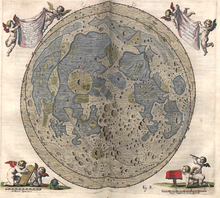Selenographia sive Lunae Descriptio
Selenographia sive Lunae Descriptio ( Latin , Selenography or the description of the moon ) is a work by Johannes Hevelius , which was published in 1647 in the Offizin Hünfeld, Danzig .
content
The Selenographia contains a very precise cartography of the moon based on Hevelius' own observations. Various views of the moon and drawings of the astronomical devices used are depicted in 133 copper engravings .
In the written work, the author compares his own research with that of Galileo Galilei and shows certain differences. Hevelius also points out that the quality of the lunar records in Galileo's Sidereus Nuncius of 1610 is insufficient.
Importance of the work
The Selenographia is dedicated to King Władysław IV. Wasa and together with the work Almagestum novum astronomiam by Giovanni Riccioli and Francesco Maria Grimaldi , it became the standard work on the doctrine and cartography of the moon for more than a century.
The book became groundbreaking for the design of scientific works in the following decades because of the print image and the copper engravings used. Isaac Newton based his work Philosophiae Naturalis Principia Mathematica, for example, on the Selenographia by Hevelius.
Copies
Several copies of the book are still preserved today and can be found in the following locations, for example:
- In Germany in the University and Research Library Erfurt / Gotha (signature Math 2 ° 00043/02, Ilf IX 2 ° 00859 and N 2 ° 00015), in the Lower Saxony State and University Library Göttingen (signature 2 ASTR II, 3803 RARA), in the Herzog-August-Bibliothek Wolfenbüttel (call number 2.5 Astron. 2 °), in the University and State Library Saxony-Anhalt in Halle (call number Pd 3526, 2 ° and Sternw. 4450, 2 °), in the Heidelberg University Library ( call number 83 K 85 RES) as well as in the Saxon State Library / State and University Library Dresden (call number Astron. 61, misc. 1).
- In the Bibliothèque nationale de France
- In the library of the Polska Akademia Nauk
- In the Thomas Fisher Rare Book Library at the University of Toronto
- In the Gunnerus Library of the Technical and Scientific University of Norway in Trondheim
- In the Austrian National Library in Vienna
- In the Memorial Library, Special Collections of the University of Wisconsin-Madison
Individual evidence
- ↑ Admission in VD 17 .
- ↑ a b Roland Lüthi: Spezialsammlungen Digital - Johannes Hevelius: Selenographia (Danzig, 1647) . Retrieved February 21, 2010.
- ↑ Observing the Moon Throughout History . ( Memento from September 28, 2007 in the Internet Archive ) Adler Planetarium, Chicago .
- ↑ digitized version .
- ^ Selenographia by Johann Hevelius ( Memento from February 6, 2012 in the Internet Archive )

